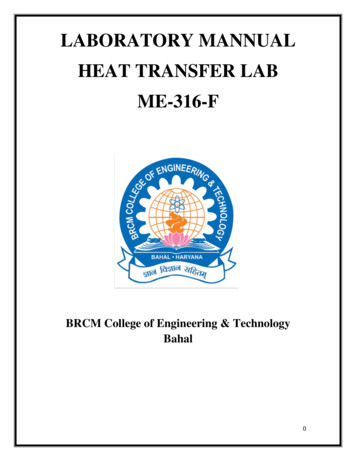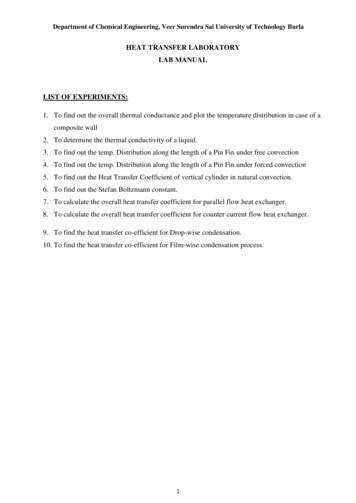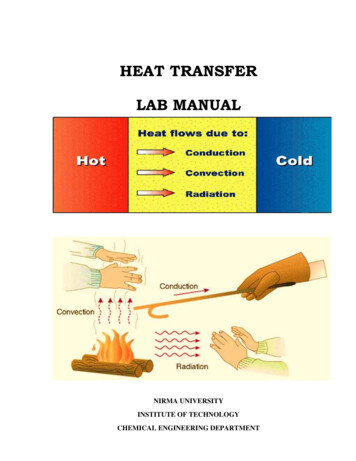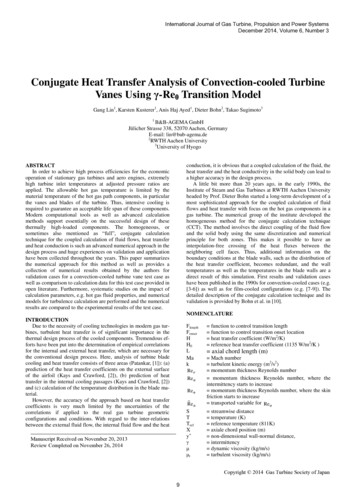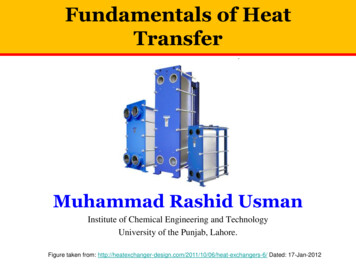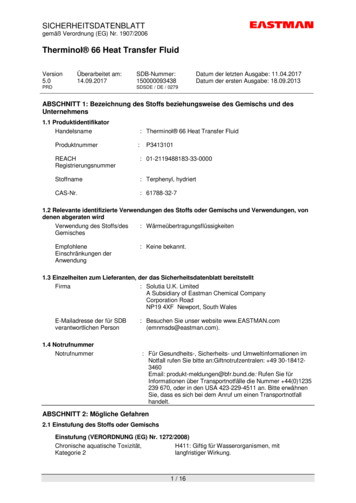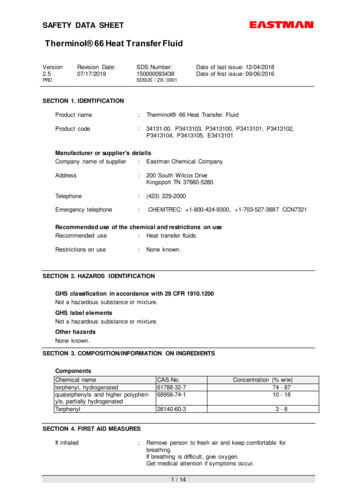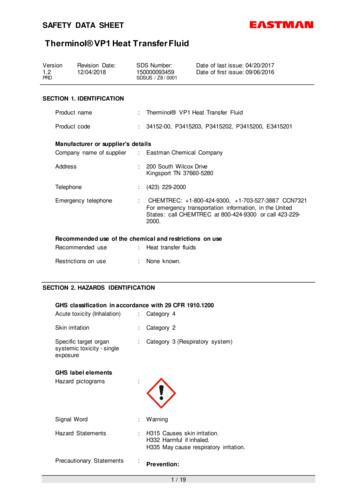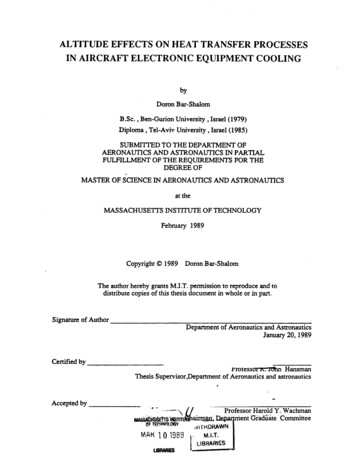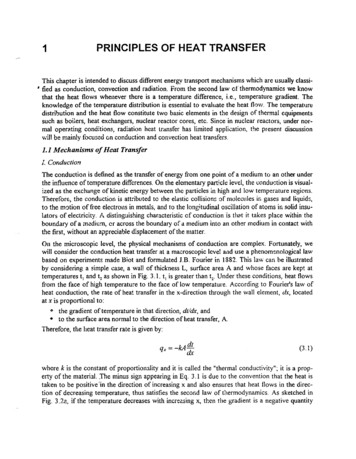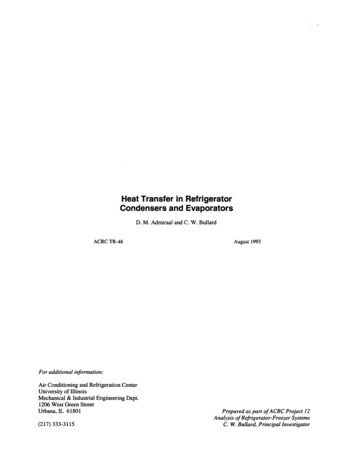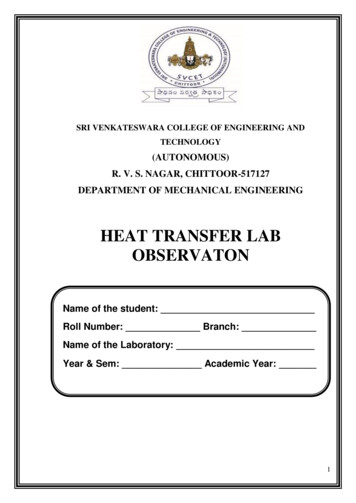
Transcription
SRI VENKATESWARA COLLEGE OF ENGINEERING ANDTECHNOLOGY(AUTONOMOUS)R. V. S. NAGAR, CHITTOOR-517127DEPARTMENT OF MECHANICAL ENGINEERINGHEAT TRANSFER LABOBSERVATONName of the student:Roll Number: Branch:Name of the Laboratory:Year & Sem: Academic Year:1
SRI VENKATESWARA COLLEGE OF ENGINEERING & TECHNOLOGY(AUTONOMOUS) R.V.S NAGAR, CHITTOOR-517 127DEPARTMENT OF MECHANICAL ENGINEERINGHEAT TRANSFER LAB MANUALLIST OF EXPERIMENTS1. Composite wall apparatus2. Critical heat flux apparatus3. Heat transfer in drop and film wise condensation apparatus4. Emissivity measurement of radiating surfaces apparatus5. Heat transfer by forced convection apparatus6. Heat pipe demonstration apparatus7. Thermal conductivity of insulating powder apparatus8. Lagged pipe apparatus9. Heat transfer by natural convection apparatus10. Parallel flow/counter flow heat exchanger apparatus11. Heat transfer from pin-fin apparatus12. Stefan Boltzmann apparatus13. Thermal conductivity of metal rod apparatus14. Study of two phase flow apparatus15. Experiment on Transient heat conduction apparatus2
INDEXS.No:DateName of the ExperimentPage No:Signature of theFaculty1234567891011121314153
Date:Exp No:COMPOSITE WALL APPARATUSAIM:To find out total thermal resistance and total thermal conductivity ofcomposite wall.DESCRIPTION:The apparatus consists of central heater sandwiched between the slabs ofMS, Asbestos and Wood, which forms composite structure. The whole structure iswell tightened make perfect contact between the slabs. A dimmer stat is providedto vary heat input of heaters and it is measured by a digital volt meter andammeter. Thermocouples are embedded between interfaces of slabs. A digitaltemperature indicator is provided to measure temperature at various points.SPECIFICATION:1. Slab assembly arranged symmetrically on both sides of the Heater.2. Heater coil type of 250-Watt capacity.3. Dimmer stat open type, 230V, 0-5 amp, single phase.4. Volt meter range 0-270V5. Ammeter range 0-20A6. Digital temperature indicator range 0-8000 c7. Thermocouple used: Teflon coated, Chromal - Alumal8. Slab diameter of each 150 mm.9. Thickness of mild steel 10 mm.10. Thickness of Asbestos 6 mm.11. Thickness of wood 10 mm.PROCEDURE:1. Start the main switch.4
2. By adjusting the dimmer knob give heat input to heater. (Say 60V).3. Wait for about 20 -30 min. approximately to reach steady state.4. Take the readings of all (8) thermocouples.5. Tabulate the readings in observation table.6. Make dimmer knob to “zero” position and then put main switch off.7. Repeat the procedure for different heat input.OBSERVATION TABLE:Sl.NoVIVolts ampsT1 CT2 CT3 CT4 CT5 CT6 CT7 CT8 C1.2.3.FORMULAE:1. Heat input Q VX IWatts .25
T1 T8 C .2T TT Asbestos 2 7 C .2T TT Mild steel 3 6 C 2T TT Heater 4 5 C .2TWood 2. Area of Slab d2 2m (Where “d” is diameter of slab 300 mm)43. Thermal Resistance of Slab ( R )T -TR heater wood C/WQ4. Thermal Conductivity ( K )QxtWK (Where “t” is total thickness of slab 26mm)A(T heater - T wood ) m kA PRECAUTIONS:1. Keep the dimmer stat to zero before starting the experiment.2. While removing plates do not disturb thermocouples.3. Use the selector switch knob and dimmer knob gently.RESULT:1. Total thermal resistance of composite wall .2. Total thermal conductivity of composite wall 6
Date:Exp No:CRITICAL HEAT FLUX APPARATUSAIM:To study the phenomenon of the boiling heat transfer and to plot the graphof heat flux versus temperature difference.APPARATUS:It consists of a cylindrical glass container, the test heater and a heater coilfor initial heating of water in the container. This heater coil is directly connected tothe mains and the test heater is also connected to the mains via a Dimmer stat andan ammeter is connected in series to the current while a voltmeter across it to readthe voltage.The glass container is kept on the table. The test heater wire can be viewedthrough a magnifying lens. Figure enclosed shows the set up.SPECIFICATIONS:1. Length of Nichrome wireL 52mm2. Diameter of Nichrome wireD 0.25 mm (33 gauge)3. Distilled water quantity 4 liters4. Thermometer range: 0 – 100 0C5. Heating coil capacity (bulk water heater ) : 2 kW6. Dimmer stat7. Ammeter8. Voltmeter7
THEORY:When heat is added to a liquid surface from a submerged solid surfacewhich is at a temperature higher than the saturation temperature of the liquid, it isusual that a part of the liquid to change phase. This change of phase is called‘boiling’. If the liquid is not flowing and present in container, the type of boiling iscalled as ‘pool boiling’. Pool boiling is also being of various types depending uponthe temperature difference between the surfaces of liquid. The different types ofzones are as shown in the figure A. The heat flux supplied to the surface is plottedagainst (Tw - Ts) where Ts is the temperature of the submerged solid and ‘Tw’ is thesaturation temperature of the liquid at exposed pressure. The boiling curve can bedivided into three regions:I.II.III.Natural convection regionNucleate boiling regionFilm boiling regionFigure A TYPICAL POOL BOILING CURVEAs temperature difference (Tw - Ts) is very small (10C or so), the liquid nearto the surface gets slightly superheated and rises up to the surface. The heat8
transfer from the heating surface to the liquid is similar to that by naturalconvection and hence this region is called ‘natural convection region’.When (Tw - Ts) becomes a few degrees, vapor bubble start forming at somediscrete locations of the heating surface and we enter into ‘Nucleate boilingregion’. Region II consists of two parts. In the first part, the bubbles formed arevery few in number and before reaching the top liquid surface, they get condensed.In second part, the rate of bubble formation as well as the locations where they areformed increases with increase in temperature difference. A stage is finally reachedwhen the rate of formation of bubbles is so high that they start coalesce and blanketthe surface with a vapor film. This is the beginning of region III since the vaporhas got very low thermal conductivity, the formation of vapor film on the heatingsurface suddenly increases the temperature beyond the melting point of thesubmerged surface and as such the end of ‘Nucleate boiling’ is important and itslimiting condition is known as critical heat flux point or burn out point.The pool boiling phenomenon up to critical heat flux point can be visualizedand studied with the help of apparatus described above.PROCEDURE:1. Distilled water of about 5 liters is taken into the glass container.2. The test heater (Nichrome wire) is connected across the studs and electricalconnections are made.3. The heaters are kept in submerged position.4. The bulk water is switched on and kept on, until the required bulk temperatureof water is obtained. (Say 400 C )5. The bulk water heater coil is switched off and test heater coil is switched on.6. The boiling phenomenon on wire is observed as power input to the test heatercoil is varied gradually.7. The voltage is increased further and a point is reached when wire breaks(melts) and at this point voltage and current are noted.8. The experiment is repeated for different values of bulk temperature of water.(Say 600 C, and 800 C).9
OBSERVATION TABLE:Sl.NoBulk waterTemperaturein 0C‘T w’Specimentemperature in Heat Input‘Q’in wattCritical heatFlux q Q/AIn W/m2123456789101112131415161718192021222324252610
MODEL CALCUALATIONS:a. Area of Nichrome wire A π x D x L b. Heater input Q V x I c. Critical heat flux q Q/A PRECAUTIONS:1. All the switches and Dimmer stat knob should be operated gently.2. When the experiment is over, bring the Dimmer stat to zero position.3. Run the equipment once in a week for better performance.4. Do not switch on heaters unless distilled water is present in the container.RESULT:The phenomenon of the boiling heat transfer is studied and plotted the graphof the heat flux versus temperature difference and critical heat flux is calculated.Critical heat flux q -------------11
Date:Exp No:HEAT TRANSFER IN DROP AND FILM WISE CONDENSATIONAIM:To determine the experimental and theoretical heat transfer coefficient fordrop wise and film wise condensation.INTRODUCTION:Condensation of vapor is needed in many of the processes, like steamcondensers, refrigeration etc. When vapor comes in contact with surface havingtemperature lower than saturation temperature, condensation occurs. When thecondensate formed wets the surface, a film is formed over surface and thecondensation is film wise condensation. When condensate does not wet thesurface, drops are formed over the surface and condensation is drop wisecondensationAPPARATUS:The apparatus consists of two condensers, which are fitted inside a glasscylinder, which is clamped between two flanges. Steam from steam generatorenters the cylinder through a separator.Water is circulated through thecondensers. One of the condensers is with natural surface finish to promote filmwise condensation and the other is chrome plated to create drop wise condensation.Water flow is measured by a Rota meter. A digital temperature indicator measuresvarious temperatures. Steam pressure is measured by a pressure gauge. Thus heattransfer coefficients in drop wise and film wise condensation cab be calculated.SPECIFICATIONS:Heater: Immersion type, capacity 2kWVoltmeter: Digital type, Range 0-300vAmmeter: Digital type, Range 0-20 ampsDimmer stat: 0-240 V, 2 ampsTemperature Indicator: Digital type, 0-800 C12
Thermocouple Used: Teflon coated, Chromal - Alumal (Ch-Al)Diameter of copper tubed 16 mmLength of copper tubeL 300 mm: 2kg/cm2Maximum Capacity of boilerEXPERIMENTAL PROCEDURE:1. Fill up the water in the steam generator and close the water-filling valve.2. Start water supply through the condensers.3. Close the steam control valve, switch on the supply and start the heater.4. After some time, steam will be generated. Close water flow through one of thecondensers.5. Open steam control valve and allow steam to enter the cylinder and pressuregauge will show some reading.6. Open drain valve and ensure that air in the cylinder is expelled out.7. Close the drain valve and observe the condensers.8. Depending upon the condenser in operation, drop wise or film wisecondensation will be observed.9. Wait for some time for steady state, and note down all the readings.10. Repeat the procedure for the other condenser.OBSERVATIONS:‘V’VoltThermocouple readings(0C)‘I’AmpT1T2T3T4T5T6T7T8Volume flowrate ofwater, Vcc/minWater inlet temperature -T1Copper tube surface temperature (Film wise condensation) -T2Copper specimen chamber steam temperature - T3Gold tube surface temperature (Drop wise condensation) -T4Gold specimen chamber steam temperature - T5Steam Inlet temperature - T6Copper tube Water outlet temperature - T7Gold tube Water outlet temperature - T813
CALCULATIONS:(FILM WISE & DROP WISE CONDENSATION)Water flowmw kg/secWater inlet temperature oCoWater outlet temperature C(T8 for drop-wise condensation and T7 for film-wise condensation)Heat carried away by the water,Q mw.cP. (T7 or 8 -T1) WattsQ WattsWhere cp Specific heat of water 4.2 x 103J / Kg-KSurface area of the condenser, A πdL m2Experimental heat transfer coefficient, h QoW / m2 CA(Ts Tw )(for both film wise and drop wise condensation)Where Ts Temperature of steam (T3 or T5)TW Condenser wall temperature (T2 or T4)Theoretically, for film wise condensation h fg . 2 .g.k 3 h 0.943 (Ts Tw ). .L 0.25Wherehfg Latent heat of steam at TS J/kg(Take from temperature tables in steam tables)ρ Density of water, Kg / m3g Gravitational acceleration, m / sec2k Thermal conductivity of water W / mo Cμ Viscosity of water, N.s/m2L Length of condenser 0.15 mAbove values at mean temperature, Tm (Ts TW )2oC (from data book)14
(For drop wise condensation, determine experimental heat transfercoefficient only) In film wise condensation, film of water acts as barrier to heattransfer whereas, in case of drop formation, there is no barrier to heat transfer,Hence heat transfer coefficient in drop wise condensation is much greater than filmwise condensation, and is preferred for condensation. But practically, it is difficultto prolong the drop wise condensation and after a period of condensation thesurface becomes wetted by the liquid. Hence slowly film wise condensation starts.PRECAUTIONS:1. Operate all the switches and controls gently2. Never allow steam to enter the cylinder unless the water is flowing throughcondenser.3. Always ensure that the equipment is earthed properly before switching on thesupply.RESULTS:Thus we studied and compared the drop wise and film wise condensation.1. Film wise condensation:Experimental average heat transfer coefficient Theoretical average heat transfer coefficient 2. Drop wise condensation:Experimental average heat transfer coefficient Theoretical average heat transfer coefficient 15
Date:Exp No:EMISSIVITY MEASUREMENT OF RADIATING SURFACESAIM:To determine the emissivity of given test plate surface.THEORY:Any hot body maintained by a constant heat source, loses heat tosurroundings by conduction, convection and radiation. If two bodies made of samegeometry are heated under identical conditions, the heat loss by conduction andconvection can be assumed same for both the bodies, when the difference intemperatures between these two bodies is not high. In such a case, when one bodyis black & the other body is gray from the values of different surface temperaturesof the two bodies maintained by a constant power source emissivity can becalculated. The heat loss by radiation depends ona)Characteristic of the materialb)Geometry of the surface andc)Temperature of the surfaceThe heat loss by radiation when one body is comp
HEAT TRANSFER LAB MANUAL LIST OF EXPERIMENTS 1. Composite wall apparatus 2. Critical heat flux apparatus 3. tHH ee aatt ntrraann ssffeerr ii nn ddrr oopp anndd ffiillmm ww iise ccoo nddeenssaattiionn apparatus 4. Emissivity measurement of radiating surfaces apparatus 5. Heat transfer by forced convection apparatus 6. Heat pipe demonstration apparatus 7. Thermal conductivity

